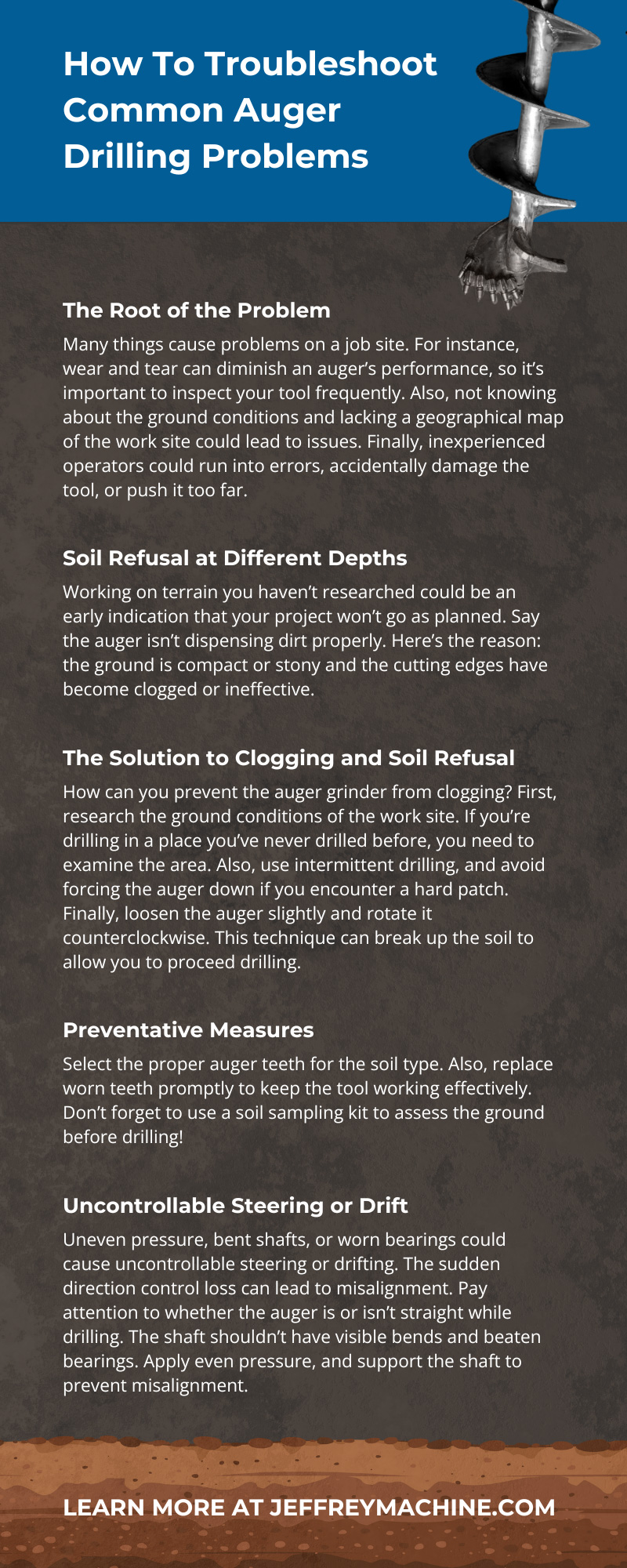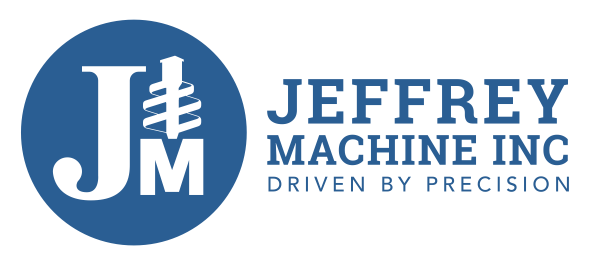How To Troubleshoot Common Auger Drilling Problems

The backbone of any good foundation drilling job is an auger. However, you may encounter issues with this attachment, requiring everyone on the worksite to stop. Understanding the common problems with auger drilling and how to tackle them is essential for keeping your job site safe. We’ll walk you through said problems and offer troubleshooting tips. Whether you’re dealing with soil refusal, helical flight cracks, or other complications, our guide will help you face these problems head-on.
The Root of the Problem
Many things cause problems on a job site. For instance, wear and tear can diminish an auger’s performance, so it’s important to inspect your tool frequently. Also, not knowing about the ground conditions and lacking a geographical map of the work site could lead to issues. Finally, inexperienced operators could run into errors, accidentally damage the tool, or push it too far.
Soil Refusal at Different Depths
Working on terrain you haven’t researched could be an early indication that your project won’t go as planned. Say the auger isn’t dispensing dirt properly. Here’s the reason: the ground is compact or stony and the cutting edges have become clogged or ineffective.
The Solution to Clogging and Soil Refusal
How can you prevent the auger grinder from clogging? First, research the ground conditions of the work site. If you’re drilling in a place you’ve never drilled before, you need to examine the area. Also, use intermittent drilling, and avoid forcing the auger down if you encounter a hard patch. Finally, loosen the auger slightly and rotate it counterclockwise. This technique can break up the soil to allow you to proceed drilling.
Preventative Measures
Select the proper auger teeth for the soil type. Also, replace worn teeth promptly to keep the tool working effectively. Don’t forget to use a soil sampling kit to assess the ground before drilling!
Uncontrollable Steering or Drift
Uneven pressure, bent shafts, or worn bearings could cause uncontrollable steering or drifting. The sudden direction control loss can lead to misalignment. Pay attention to whether the auger is or isn’t straight while drilling. The shaft shouldn’t have visible bends and beaten bearings. Apply even pressure, and support the shaft to prevent misalignment.
Preventative Measures
Always store and transport your drilling equipment safely to reduce the risk of bending the shaft. Also, follow the proper drilling process, ensuring consistent pressure and alignment at all times.
Helical Flight Cracks
What could go wrong if the helical flight cracks? Fissures develop down the auger’s spiral from repeated stress on the flight. Cracks could seem minor, but they can grow and cause significant performance issues.
How To Fix Helical Flight Cracks: Are They Preventable?
These cracks are not curable, and you can’t do much else to fix the problem aside from replacing the flight. To prevent damage on your new set of helical flights, control the running speed of the auger grinder. Also, keep in mind that the soul type and the digging depth can affect the helical flight condition.
Vibrations and Unusual Noises
Unusual vibrations or noises during drilling can signal a variety of problems, from loose parts to damaged components. These issues can be serious enough to halt work for a day or more.
Is There a Solution?
Yes—turn off the rig immediately once a problem arises! Next, inspect every moving part, and tighten anything that could be causing the issue. If it persists, replace the affected areas. The best way to prevent this problem is to do regular inspections and tighten components, as they’re the first signs of potential auger problems.
Power Drives Aren’t Working
How do you know if a power drive on an auger isn’t working? You can usually tell if it’s frequently down or has a weak performance. Sometimes, the problem comes from a lead rod issue or something with the electrical or hydraulic system.
The Solution to Auger Power Drive Problems
Examine the lead rod first when doing a systematic check of the power drive. Then, inspect the electrical and hydraulic connections to ensure they’re secure and functional. For hydraulics, check the fluid levels and the system’s pressure, and for electrical issues, examine the wiring and control systems. Another solution is to prevent power drive problems from happening in the first place. You can do this by replacing worn parts and testing the power drive often.
Drilling Slows or Stops Unexpectedly
Other problems that may arise in foundation drilling are unexpected slowdowns or complete stoppages. These problems happen for many reasons, like mechanical or operational issues, power loss, hydraulic fluid leaks, or stuck debris.
The Solution and Preventative Measures
You can troubleshoot slow drilling and sudden halts by checking for leaks, as they can affect hydraulic pressure. If the issue isn’t hydraulically based, it may be due to something clogging the cutting head or flighting, which requires stopping and clearing before resuming drilling. You can solve this dilemma through regular inspections for leaks and blockages and periodically flushing the hydraulic system. Additionally, track these problems and identify patterns that could point to the source.
Drilling Too Slowly Through Soft Soil
Soft soil might seem simple to drill through, but your auger attachment shouldn’t move any slower than usual. Worn teeth or a dull auger can lead to slow drilling. The quickest solution is to inspect the auger teeth for excessive wear or bluntness. You can prevent future problems by scheduling regular check-ups for the equipment and keeping spare teeth on-site so you can replace them immediately if needed.
Deterioration of Concrete During Auger Installation
If you’re drilling through hard material like concrete, you might notice cracking or deterioration around the supports. The best solution is to review your drilling process and the materials you’re penetrating. If your auger isn’t lined up correctly (rebar is touching the auger during operation), you could break the rebar.
Review the blueprints and drilling locations to avoid rebar. Adjust the drilling process by using smaller augers or manual control to clear rebar areas.
Drill Better With Jeffrey Machine
Troubleshooting these common auger drilling problems is essential for maintaining a productive and safe construction environment. By understanding the root of an issue and proactively engaging in maintenance and prevention, your drilling equipment will serve you well for years to come. Troubleshooting is a skill that, like any other, improves with practice.
If you’re looking to secure reliable, durable augers and avoid common drilling problems, Jeffrey Machine provides foundation augers for sale. Contact us to find the perfect auger for your needs and elevate your construction game.

